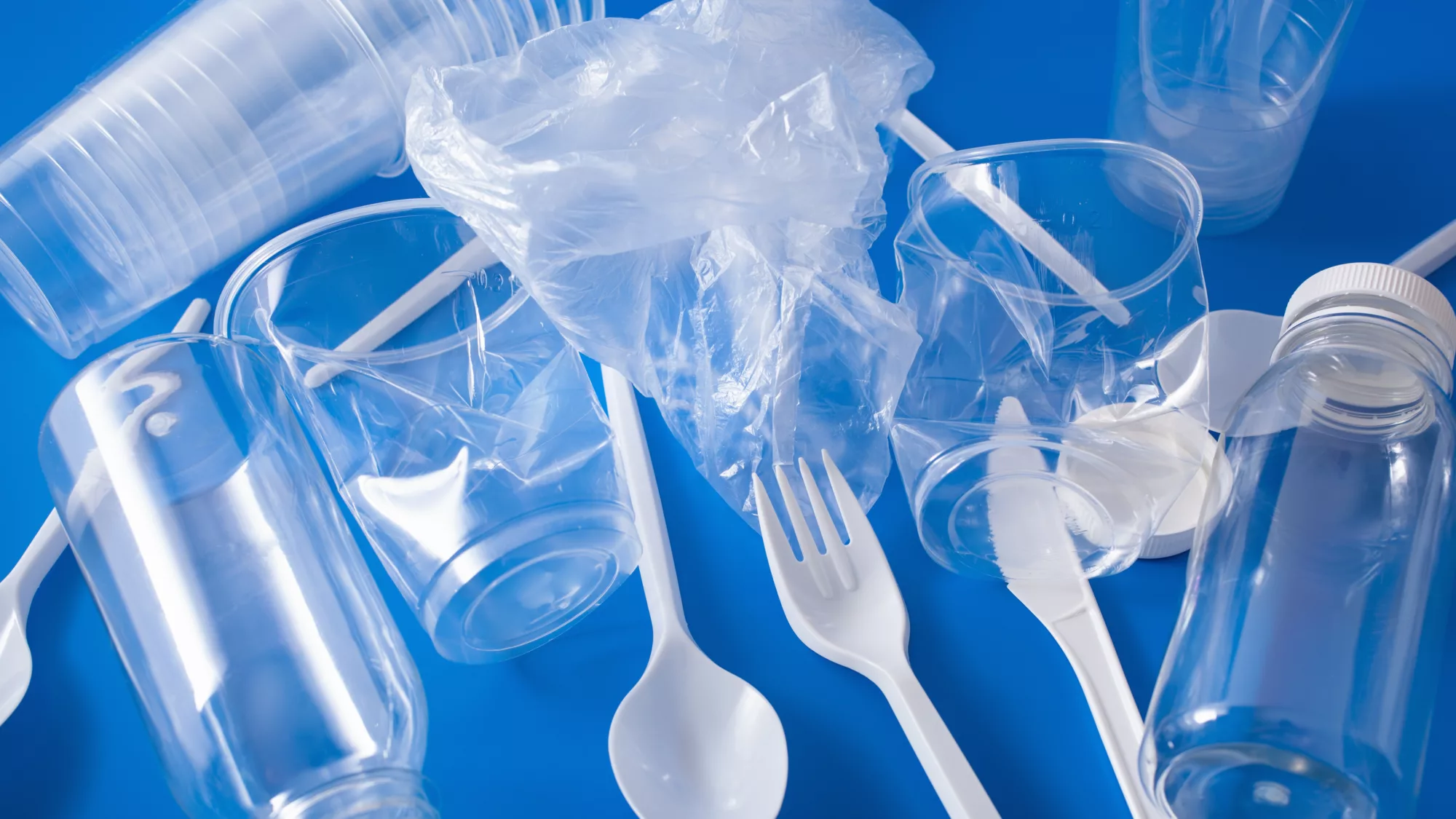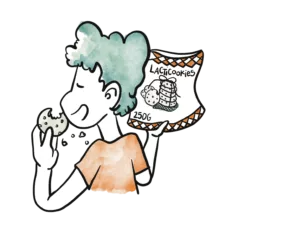- Behind the SUP Directive
In the middle of the climate crisis, plastic appear to be one of the problems at the spotlight. Action is required to overcome the damage that plastic is causing to environment. On European area alone, more than 25 million tonnes of plastic waste are generated yearly, and only 30% is collected for recycling, while 85% of marine pollution comes from this source[1]. Plastic waste exports[2] going to Turkey, Malaysia, Vietnam, Thailand or Indonesia coming from European Union countries continued at high levels at the end of 2020.
Among the impacts of plastic pollution, single-use and disposable items (such as bags, straws, coffee cups, beverage bottles and most food packaging) are growing as each year more plastic waste accumulates in our environment and oceans1.
- What is the SUP Directive
Its real name is DIRECTIVE (EU) 2019/904 OF THE EUROPEAN PARLIAMENT AND OF THE COUNCIL of 5 June 2019 on the reduction of the impact of certain plastic products on the environment, however, it is commonly known as the Single Use Plastics (SUP) Directive.
The SUP Directive was first proposed to tackle single-use plastic products which are the most founded on beaches and fishing gear.
As stated in the Directive, ‘single-use plastic product’ means a product that is made wholly or partly from plastic and that is not conceived, designed or placed on the market to accomplish, within its life span, multiple trips or rotations by being returned to a producer for refill or re-used for the same purpose for which it was conceived;
According to this definition, the Single-Use Plastic Directive includes in its scope other products laminated with plastic, such as paper packaging and plates made of paper with a plastic layer (also known as coated paper).
All types of plastic are included in the scope of the Directive, even biobased and biodegradable plastics. Except from unmodified natural polymers, within the meaning of the definition of ‘not chemically modified substances’ in point 40 of Article 3 of Regulation (EC) No 1907/2006 of the European Parliament and of the Council[3].
In the scope of the Single-Use Plastic Directive, we can find several categories of products, as can be seen in the Table 1. Each of these categories of products (food containers, cup for beverages, etc) are subject to different measures (consumption reduction, product ban, product design, etc.). So, according to this information, it is important to understand that the Single-Use Plastic Directive is not going to ban all Single Use Plastic products.
- Food containers in SUP
“Food containers” was one of the categories which caused most controversy and aroused more questions: Which food containers are under the scope of the Directive? What are the measures applied to them?
Several types of food containers are included in the Single-Use Plastic Directive: take-away packaging, packets and wrappers, beverage bottles, cups for beverages… Depending on the category, different measures will apply to these products. In this article we will only focus on food containers, excluding beverage packaging.
Table 1. Product categories and measure applied in SUP Directive
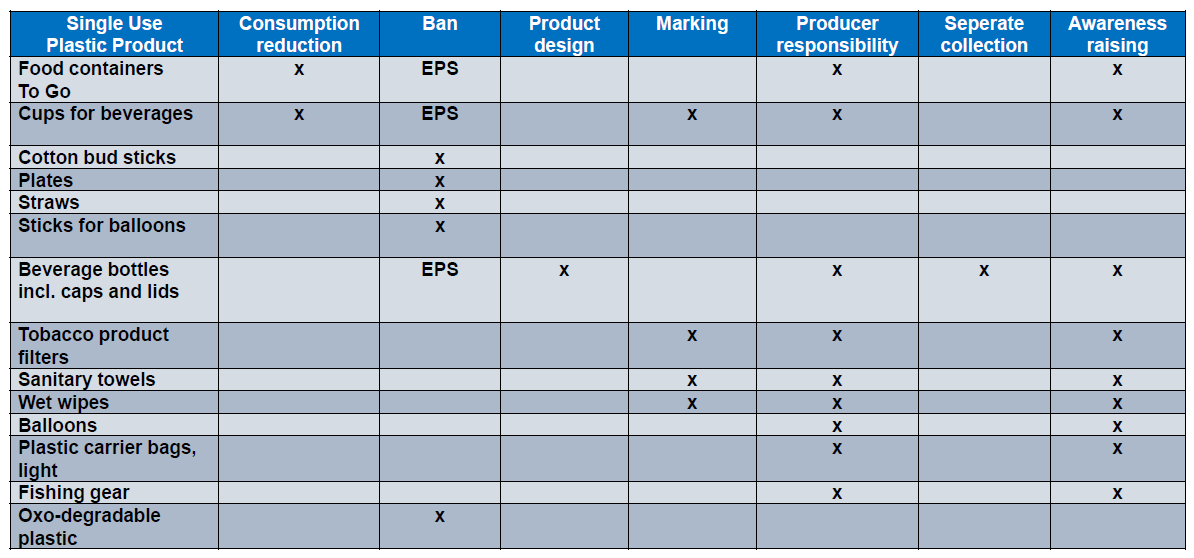
- Rigid food containers in the scope of the Directive
According to the definitions given by the SUP Directive, food containers refer to the packaging used to contain food that will be consumed immediately (commonly known as take-away packaging):
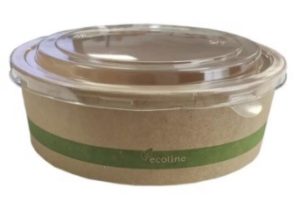
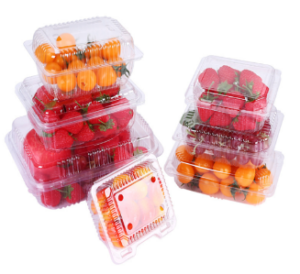
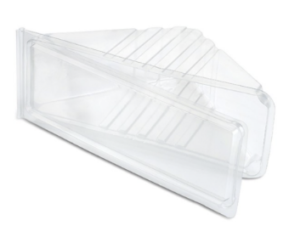
“Food containers, i.e. receptacles such as boxes, with or without a cover, used to contain food which:
(a) is intended for immediate consumption, either on-the-spot or take-away,
(b) is typically consumed from the receptacle, and
(c) is ready to be consumed without any further preparation, such as cooking, boiling or heating, including food containers used for fast food or other meal ready for immediate consumption, except beverage containers, plates and packets and wrappers containing food.”
The following concept map can help to understand whether a food packaging is included, or not, under the scope of the Directive:

Further information regarding the definition and examples of these kind of packaging can be found in the Commission guidelines on single-use plastic products in accordance with Directive (European Union) 2019/904 of the European Parliament and of the Council on the reduction of the impact of certain plastic products on the environment.
- Flexible food containers in the scope of the Directive: Packets and wrappers
According to the SUP Directive, “packets and wrappers” are plastic or plastic-coated products made of flexible material containing food for immediate consumption:
“Packets and wrappers made from flexible material containing food that is intended for immediate consumption from the packet or wrapper without any further preparation”[4]
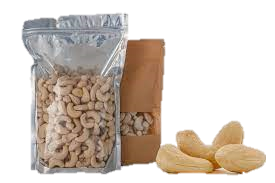
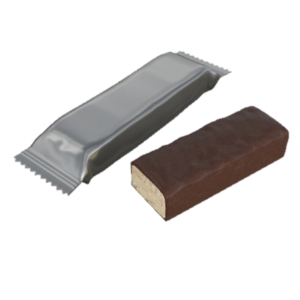
The following concept map can help to understand whether a food packaging is included, or not, under the scope of the Directive:
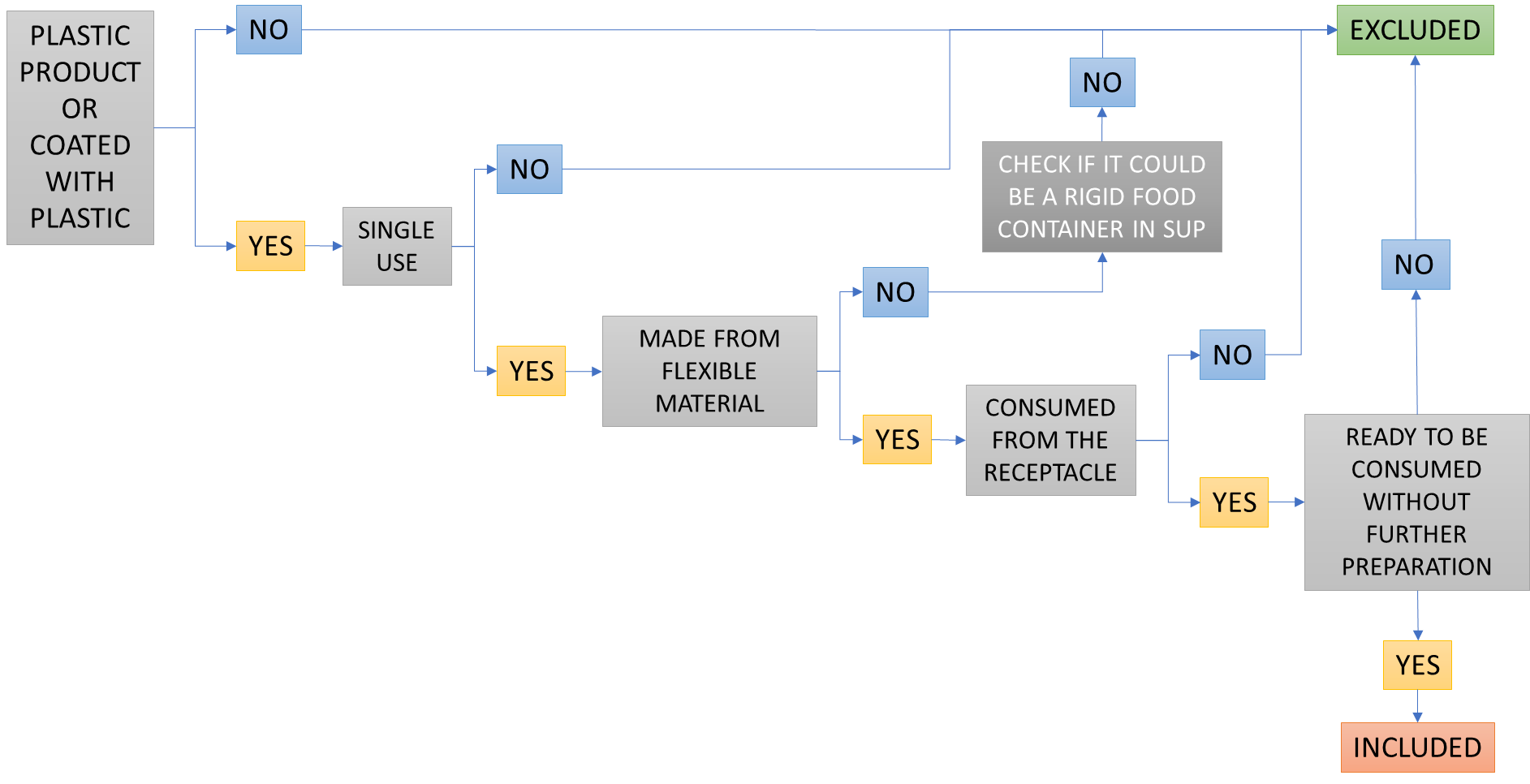
Further information regarding the definition and examples of these kind of packaging can be found in the Commission guidelines on single-use plastic products in accordance with Directive (European Union) 2019/904 of the European Parliament and of the Council on the reduction of the impact of certain plastic products on the environment.
- Measures applied to food packaging products[5]
As explained before not all products are covered by the same measures, consumption reduction measures will be applied to food packaging mentioned in part 3.1, only extended polystyrene food packaging have been banned in Europe, while extended producer responsibility and awareness raising measures apply to both categories of food packaging explained in this article.
- Consumption reduction (only for rigid packaging products mentioned in part 3.1)
Member States are responsible to take measures to achieve ambitious and sound reduction in the consumption of single-use food packaging products as specified in part 3.1 of this article. Those measures shall achieve a measurable quantitative reduction in the consumption of the single-use plastic food packaging products of the Member State by 2026 compared to 2022.
By July 3rd of 2021, Member States were supposed to prepare a description of these measures and notify to the Commission. The measures may include national consumption reduction targets, measures ensuring that re-usable alternatives to the single-use plastic food packaging products are made available at the point of sale to the final consumer.
- Product ban (only EPS products included in part 3.1)
Only rigid food containers, as specified in 3.1, made of expanded polystyrene have been prohibited in Europe since July 2021, i.e. receptacles such as boxes, with or without a cover, used to contain food which:
- is intended for immediate consumption, either on-the-spot or take-away,
- is typically consumed from the receptacle, and
- is ready to be consumed without any further preparation
- Extended producer responsibility
Member States shall ensure that extended producer responsibility schemes are established for single-use plastic products listed in part 3.1 and 3.2 of this article which are placed on the market of the Member State, in accordance with Articles 8 and 8a of Directive 2008/98/EC. Member States shall ensure that the producers cover the costs pursuant to the extended producer responsibility provisions in Directives 2008/98/EC and 94/62/EC and, insofar as not already included, cover the following costs:
- the costs of the awareness raising measures referred to in Article 10 of this Directive regarding those products;
- the costs of waste collection for those products that are discarded in public collection systems, including the infrastructure and its operation, and the subsequent transport and treatment of that waste;
- the costs of cleaning up litter resulting from those products and the subsequent transport and treatment of that litter.
- Awareness raising
According to Article 10, Member States along Europe will be responsible to inform consumers and to promote responsible consumer behaviour to reduce litter from food packaging included in the Directive. This information includes the availability of reusable alternatives and the impact of littering and other inappropriate waste disposal of single use products.
- What are the options?
Europe seems to be pushing for reusability. And indeed, incentivise the use of reusable packaging for the consumption of “fast” products which are intended for immediate consumption without further preparation seems to be the best option in terms of saving environmental impact. However, establishments such as supermarkets or restaurants need to offer alternatives in case their clients are not bringing with them a reusable option.
These alternatives have been, up to now, led by paper packaging. However, paper products need grease barrier to make sure that the consumption is convenient for the customer. For many years, PFAS have been used to provide this barrier, however these chemicals have been found to be extremely dangerous for human health and environment. PFAS is a large family of over 4,500 compounds, also known as “Forever Chemicals” due to their extreme persistence in the environment. PFAS are widely used in disposable food packaging and tableware in Europe. This includes food packaging from popular fast-food chains and restaurants. [6]
Other options for paper with grease and oxygen barrier are now been developed, for example, Lactips offers solutions like Plastic Free Paper: the first paper packaging solution that is free from plastic or controversial substances and fully recyclable and compostable.
Lactips has developed, with support from the eco-organization CITEO, a new cellulose material coating solution that ensures the total recyclability of papers and cardboards. This first generation combines the paper with the thermoplastic developed by Lactips to meet the challenges relating to performance capabilities and sustainable development.
100% biosourced, home compostable and heat-sealed, the Plastic Free Paper solutions provide the oxygen, fat and mineral oil barriers that are essential for preserving food products. This material is fully compliant with food contact standards.
Tests carried out with Centre Technique du Papier (CTP) in France and Papiertechnische Stiftung (PTS) in Germany have confirmed that there is no impact on the recyclability of the papers and cardboards for the first two applications available:
Replacing the sealable plastic layer for non-food packaging, such as mailing films or food films for dry or fatty products (tea bags, confectionery, pet chews, etc.)
Replacing per- or poly-fluorinated alkyl substances (PFAS) for papers that need to be grease-proof (e.g. fast food packaging)
The Plastic Free Paper solutions offer a real alternative for manufacturers (processors and/or brands) in the context of their environmental efforts and the application of the European directive restricting single-use plastics (Directive 2019/904/EC). The material developed by Lactips is not a plastic, but a natural material, in accordance with European Regulation no.1907/2006 (REACH), and is therefore exempt from the demands and restrictions set by this directive.

Coating material solutions with no impact on paper recycling process
[1] plastics-strategy.pdf (europa.eu)
[2] https://www.ban.org/plastic-waste-project-hub/trade-data/eu-export-data
[3] DIRECTIVE (European Union) 2019/904 OF THE EUROPEAN PARLIAMENT AND OF THE COUNCIL of 5 June 2019 on the reduction of the impact of certain plastic products on the environment
[4] DIRECTIVE (EU) 2019/904 OF THE EUROPEAN PARLIAMENT AND OF THE COUNCIL of 5 June 2019 on the reduction of the impact of certain plastic products on the environment
[5] DIRECTIVE (EU) 2019/904 OF THE EUROPEAN PARLIAMENT AND OF THE COUNCIL of 5 June 2019 on the reduction of the impact of certain plastic products on the environment
[6] Throwaway packaging forever chemicals. European wide survey of PFAS in disposable food packaging and tableware

